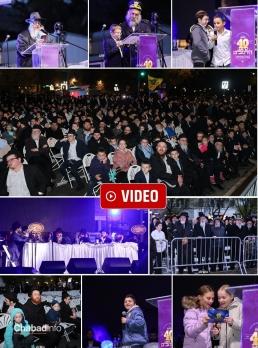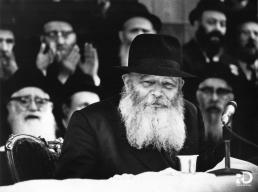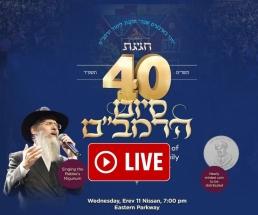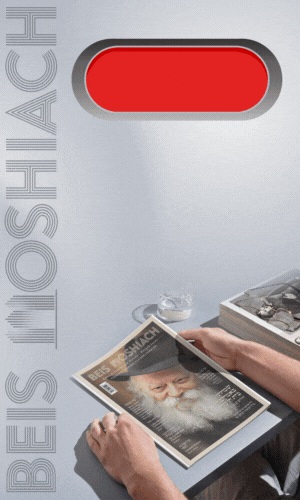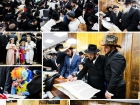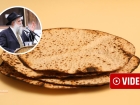Siddur Before Kiddushin
From Beis Moshiach Magazine: One of the highlights of a Chassidishe wedding is when the Chassan has the tremendous zechus to daven mincha and say vidui from the Rebbe’s siddur at the mincha before his chuppa. When did this custom start? Is the siddur the one the Rebbe uses personally? And what is the bracha the Rebbe gives the Chassan at this special time? In honor of the wedding anniversary of the Rebbe and Rebbetzin on Yud Daled Kislev, Avrohom Rainitz put together this detailed overview of this special minhag based on interviews with the Rebbe’s mazkirim and others • Full Article
By Avrohom Rainitz, Beis Moshiach Magazine
A few minutes before 3:15, in the lobby of 770, there are clear signs of preparedness in progress. Bachurim rush to enter the small zal where mincha with the Rebbe will be beginning soon; the secretary, Rabbi Chodakov is already walking from his office at the end of the corridor to his usual place next to the Rebbe; Rabbi Groner the secretary enters the Rebbe’s office as he does every day before mincha, and the secretary, Rabbi Klein, finishes final arrangements in the secretaries’ office, wanting to be ready to stand in the lobby as the Rebbe walks in for the davening.
A young chassan walks in, accompanied by family members. Excitedly, they turn left to the open door of the corridor outside the Rebbe’s room called Gan Eden Ha’tachton and stand facing the door of the Rebbe’s room which Chassidim call Gan Eden Ha’elyon.
Like Yitzchok Avinu who went up to Gan Eden before his marriage, the chassan stands at the entrance to Gan Eden Ha’elyon on the most significant day of his life, waiting for the thrilling moment when the Rebbe will come out and give the chassan his siddur while saying, “Zolst oisbetten aleh gutte zachen” (You should successfully petition for all good things.) Sometimes the Rebbe would add, “May the wedding be in a good and successful time.”
The day of the wedding, in addition to being a most joyous occasion, is also a very serious day. Aside from the fact that on this day a new chapter begins in a person’s life, on this day all of a person’s sins are forgiven like on Yom Kippur. In Jewish tradition there are a number of minhagim that cause the chassan to feel that this is his personal Yom Kippur. It is customary to fast on one’s wedding day and even to say the long vidui in mincha with “Al Cheit” from the tefilla of Yom Kippur.
The Rebbe innovated a new minhag that was in the spirit of the day and its traditional customs, infusing the inspired prayer with his holy blessings and flooding it with the deepest feelings of hiskashrus between a Chassid and his Rebbe.
For 14 Kislev, the Rebbe and Rebbetzin’s anniversary, we wanted to find out how this minhag began, what was unique about the siddur that the Rebbe gave chassanim, why it’s called “the Rebbe’s siddur” if the Rebbe did not use it to daven, and what were the rules that developed around this custom over the years.
HOW IT BEGAN
I heard about this minhag from the Rebbe’s personal secretary, Rabbi Leibel Groner a’h, at the end of one of the interviews he gave Beis Moshiach. He said:
It was at the beginning of Adar 5710. One of the top students at the time, Rabbi Moshe Kazarnovsky, who was one of the first talmidim in Tomchei Tmimim – 770, was set to get married within the shloshim of the passing of the Rebbe Rayatz, and he wanted to delay the wedding. His father, Reb Shlomo Aharon, convinced him to come with him to ask the Rebbe. R’ Shlomo Aharon presented the question to the Rebbe and the Rebbe declared that one does not postpone a wedding. The Rebbe then said to the chassan: But in order to appease you, since I have a siddur of my father-in-law, on the day of the wedding I will allow you to daven mincha from this siddur before the chuppa.
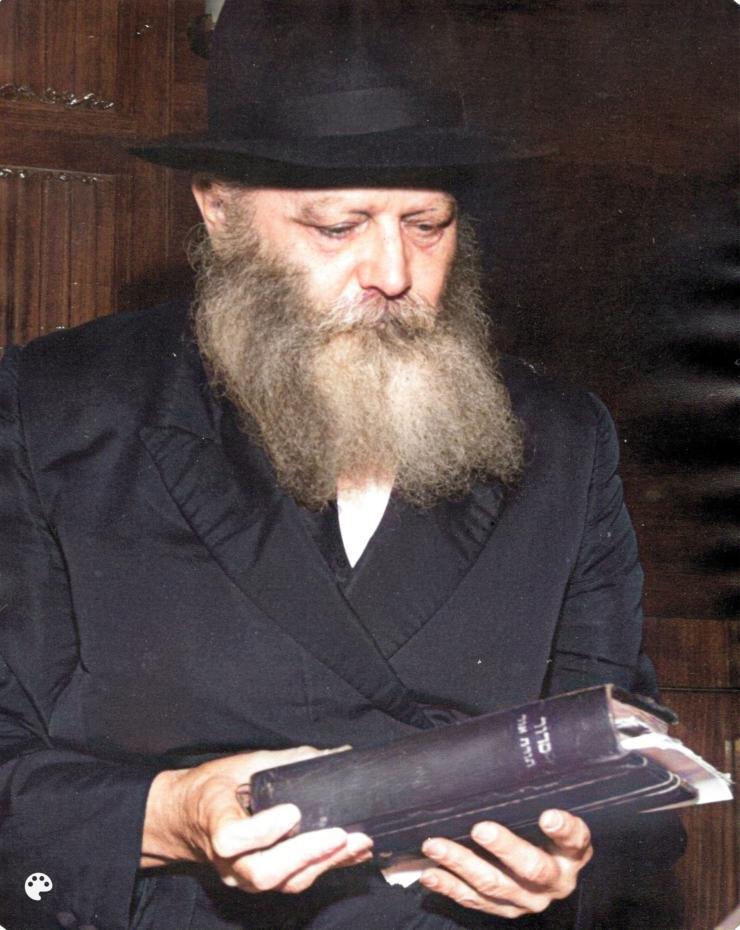


During the visit of President Shazar on Purim 5731, the Rebbe said to give his entourage a special siddur with the gold stamp “Purim 5731.” When they went out to daven, the Rebbe took his usual siddur and said to Shazar, “I also davened with this siddur but it’s already twenty years that I’ve been davening with my father-in-law’s siddur.”
On the day of his wedding, R’ Moshe went to 770 and the Rebbe took him to the second floor to the Rebbe Rayatz’s yechidus room and gave him the siddur. Then the Rebbe asked him: Where is your gartel?
Since the chassan did not have a gartel with him, the Rebbe took his own gartel (the Rebbe always wore another gartel, not only while davening, with the gartel hidden under his jacket) and gave it to the chassan on condition that he return it.
A week later there was another wedding and the chassan asked the Rebbe whether giving the siddur to the previous chassan was only an “appeasement” or whether he could also have it. The Rebbe said yes. And that is how the minhag began that every chassan received the siddur from the Rebbe on his wedding day.
ORIGINS OF THE SIDDUR
Rabbi Groner told of the origins of the siddur which the Rebbe gave to chassanim as well as the origins of the siddur that the Rebbe used.
In 5706, the Rebbe said that his father-in-law needed a new siddur. In the Rebbe’s room were several “Torah Ohr” siddurim printed by Kehos in 5701. The Rebbe took one of them and gave it to his father-in-law. The Rebbe Rayatz gave his son-in-law the siddur he used to use which the Rebbe regarded with holy awe, and placed aside in a protected place in his office.
Three years passed and in 5709 the Rebbe Rayatz once again asked his son-in-law for a siddur, saying, “I need a completely different siddur.” Once again, the Rebbe brought his father-in-law a new Torah Ohr siddur and received the Rebbe Rayatz’s old siddur. It was only after the passing of the Rebbe Rayatz in 5710 that the words, “a completely different siddur” took on a completely different meaning.
After the histalkus of the Rebbe Rayatz, when the Rebbe began to lead the davening, he used one of these two siddurim. When he went upstairs with the chassan R’ Moshe Kazarnovsky to give him the siddur, the Rebbe said, “I have another siddur,” which he gave to the chassan. After that, it was the second siddur which the Rebbe gave to chassanim.
Rabbi Groner:
After many years went by and the Rebbe gave his siddur to be bound, I thought it would be good to also bind the siddur the Rebbe gave to chassanim. I suggested this and the Rebbe said no, and said, “Don’t touch this siddur.” He explained why. “I want chassanim to put their hands on the binding which my father-in-law touched, and kiss the siddur where my father-in-law kissed it.”
I tried suggesting at least laminating the pages inside the siddur to preserve them but the Rebbe did not agree. He said, “The siddur needs to remain exactly as my father-in-law had it.”
Parenthetically, it’s interesting to note that this siddur has a printing mistake and for the twenty-ninth of the omer it says “hod of chessed.” The Rebbe Rayatz corrected this by writing “chessed of hod.” The Rebbe mentioned this at a farbrengen on Beis Iyar 5710 and said during galus it is necessary for the Nasi Yisrael to write (and draw down) “chessed of hod.”
“OZER YISROEL B’SIFARA”
As we said, the first chassan to receive the siddur from the Rebbe did not have a gartel. The reason is simple. It’s because in Chabad one wears a gartel after the wedding. At that time, the Rebbe started a new custom, that one starts wearing a gartel when davening mincha with the Rebbe’s siddur.
Over the years, one could tell who was about to receive the siddur from the Rebbe by his clothing. When you saw a bachur with a short jacket and a thick Shabbos gartel over his jacket, you knew that he was a chassan waiting to receive the siddur.
When chassanim would receive the siddur a few days before the wedding (usually, when the wedding took place out of town), the Rebbe would add an instruction about the gartel. Since the chassan already started davening with a gartel, he should continue to do so for all the tefillos before his wedding but he should wear it under the jacket.
One of the ziknei Anash said that in the early years there were a number of chassanim to whom the Rebbe gave his own gartel so that the woven threads of the gartel began to unravel (some say some chassanim unraveled a thread from the gartel to keep for themselves) and the Rebbe stopped giving his gartel.
THE TIME FOR GIVING THE SIDDUR
Since giving the siddur to chassanim was for them to daven mincha with the “Al Cheit,” the siddur was given a few minutes before mincha. This way, the chassan could go immediately to daven mincha in the Rebbe’s minyan, start his davening with the Rebbe, and then spend more time on the vidui and personal supplications.
An exception was when the Rebbe went to the Ohel. Since the Rebbe davened mincha after he returned from the Ohel, and often this was after the chuppa, the Rebbe gave the siddur to chassanim before he went to the Ohel.
When the Rebbe’s dollar distribution to tzedaka began delaying the Rebbe from going to mincha, he started giving the siddur to chassanim before he began giving out dollars. In the year of mourning for Rebbetzin Chaya Mushka, the Rebbe gave the siddur to chassanim at his home when he came down for mincha, before the davening started, in front of everyone.
CHASSANIM FROM OUT OF TOWN AND ERETZ YISRAEL
At first, the Rebbe only gave the siddur to chassanim who learned in Tomchei Tmimim. Later on, even chassanim who did not learn in Tomchei Tmimim received the siddur.
In the early years, there were hardly any chassanim from Eretz Yisrael who were by the Rebbe in the days leading up to the wedding, but there were chassanim who married out of town in the United States. They also wanted to daven from the Rebbe’s siddur on their wedding day, and they would arrange to drive or fly right after mincha, managing to daven from the Rebbe’s siddur and make it to the chuppa on time.
Then, one time, there was a chassan who missed the flight after mincha and had to wait for the next flight a few hours later and he arrived for the chuppa at midnight. After that incident, the Rebbe announced that from then on, chassanim whose weddings were taking place out of town would receive the siddur a day or two before the wedding and not on the day of the wedding.
Over the years, when the custom began that bachurim whose weddings were going to be held in Eretz Yisrael or Europe, used the engagement period to learn in 770 and prepare for the wedding there, they too began to daven from the siddur. They would ask the Rebbe for the siddur at their last mincha before they left and from then on, they davened all tefillos until their wedding with a gartel under their jacket.
Rabbi Sholom Dovber Gurkow, rosh yeshiva of Beis Sholom in Postville, who married in Montreal on 9 Sivan, had yechidus the night before the wedding. Although the Rebbe had established that someone getting married out of town would not get the siddur on the day of his wedding, he tried anyway and told the Rebbe that he did not mind getting the siddur at noon and then immediately flying to Montreal.
The Rebbe said, “It’s not appropriate for a chassan to arrive straight to the chuppa.”
Generally in yechidus, the Rebbe would go to maariv a little before midnight, usually at 11:45. However, that night, the Rebbe told the chassan he was going earlier and then he would give him the siddur. Indeed, at 9:30, the Rebbe stopped yechidus and went out to maariv.
It’s interesting that since this was in the middle of “yemei ha’tashlumim,” when tachanun is not said until after 12 Sivan, the chassan asked the Rebbe whether he should say “Al Cheit” when he davened. The Rebbe told him, “Ask rabbanim. They will probably allow you to say it.”
HOW THE SIDDUR WAS GIVEN
Usually, when the Rebbe was informed that there was a chassan waiting for a siddur, the Rebbe would leave his office shortly before mincha holding two siddurim. He would give one siddur to the chassan and take the other siddur to mincha.
After the Rebbetzin passed away, when the tefillos took place in the Rebbe’s home on President Street, giving the siddur also took place there. The Rebbe would come down from the second floor holding two siddurim and give one to the chassan who waited at the bottom of the stairs. At that time, when the Rebbe went to the Ohel and went to the car via the back door, the chassanim waited in the kitchen and got the siddur there. Of course, the chassanim and their parents preferred this arrangement which was a sort of yechidus, being alone with the Rebbe.
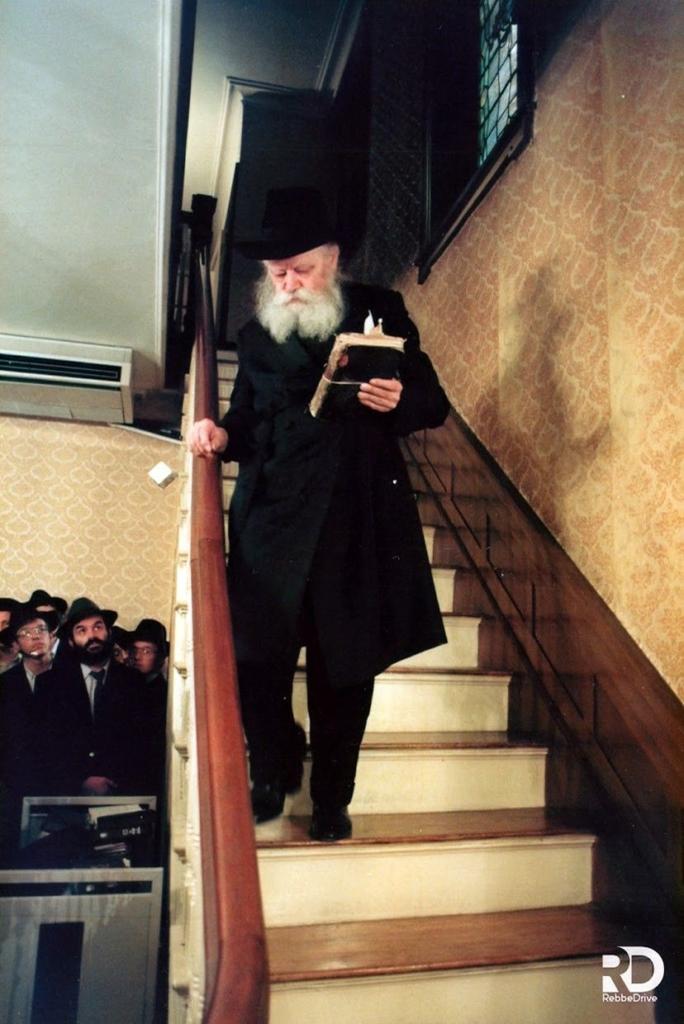


The Rebbe coming down from the second floor of his home with the siddurim.
Every rule has an exception. On rare occasions it happened that when there were two chassanim on the same day, before mincha the Rebbe gave the first chassan the siddur he usually gave chassanim, and after mincha he would give his personal siddur which he had just used to the second chassan. For example, it happened on 3 Nissan 5741, that two chassanim, Reb Hillel Dovid Krinsky and Reb Moshe Goldstein, waited in Gan Eden Ha’tachton. When the Rebbe left his office with the siddur he usually gave to chassanim, he asked them who was getting married first. R’ Hillel Dovid said that he was getting married first and the Rebbe gave him the siddur and went to mincha. When he returned from mincha, R’ Moshe was still standing there, waiting for his friend to finish davening. To his great surprise, the Rebbe gave him his own siddur which he always used for davening (after removing the papers in it).
Another time, which was described in the diary of Rabbi Mordechai Mishulovin on 8 Menachem Av 5746, he wrote about a “small drama.” In Gan Eden Ha’tachton there waited a chassan to receive a siddur from the Rebbe. The Rebbe brought the siddur out of his office and gave it to him. Afterward, he began giving out tzedaka to children. The secretary, Rabbi Groner, noticed that the Rebbe did not have a siddur (since the Rebbe, unusually, came out this time with just one siddur which he gave to the chassan). Rabbi Groner immediately went to the Rebbe’s office to get a siddur and in the meantime, in the middle of giving out coins, the Rebbe turned around in order to go into his office (apparently, to get a siddur) and in Gan Eden Ha’tachton Rabbi Groner gave the siddur to the Rebbe.
WHO TAKES PRECEDENCE?
When there were two and more chassanim, who would get the siddur directly from the Rebbe and who would get the siddur from the previous chassan?
Usually, the Rebbe made the decision but the rules changed from time to time. Sometimes, the Rebbe asked who was getting married first. Sometimes, the Rebbe opted to first give the kohen. Sometimes, the Rebbe said to hold a lottery. There were also times that the order was by age or alef-beis of their first names. The first chassan would give the siddur to the next chassan who would return the siddur to the secretaries.
Once, two chassanim showed up and the Rebbe asked who was getting married first. They said they were getting married on the same day. The Rebbe asked what time and they did not reply. The Rebbe asked: Is there a kohen or levi? And the chassan said no, they were both yisraelim. The Rebbe asked the chassan’s name and he said his last name. The Rebbe asked for his first name. His name was Shmuel and the other was Chaim Shaul. The Rebbe gave the siddur to the chassan named Chaim Shaul and blessed him, “You should successfully petition for all good things; it should be in a good and successful time,” and gave him a nickel for tzedaka. Then the Rebbe blessed the second chassan and also gave him a coin for tzedaka.
Rabbi Yaakov Micholashvili of Kfar Chabad related:
I and my two sons waited in Gan Eden Ha’tachton after mincha. With us was another chassan from Eretz Yisrael, from Rishon L’Tziyon, When the Rebbe entered Gan Eden Ha’tachton with a radiant face, he asked my son for his first name and where he was from. Avrohom answered, “I am Avrohom Tzvi Hirsh from Kfar Chabad and my wedding will be in Rishon L’Tziyon.”
The Rebbe said, “L’mazal tov.
He then asked the other chassan for his name and where he was from and the chassan answered, “My name is Yehoshua from Rishon L’Tziyon and my wedding will be in Kfar Chabad.”
The Rebbe smiled broadly and said, “The one from Kfar Chabad is getting married in Rishon L’Tziyon and the one from Rishon L’Tziyon is getting married in Kfar Chabad. The main thing, it should be with mazal tov.”
Then the Rebbe said, “In the letters of the Torah, first comes the alef and then the yud, so Avrohom will get the siddur and then Yehoshua.”
THE BRACHOS
When giving the siddur, the Rebbe blessed the chassan. He usually said, “ You should successfully petition for all good things.” On rare occasions he would add, “The wedding should be in a good and successful time.”
When there were several chassanim, after the Rebbe gave the siddur to one of them, the Rebbe said to the other, “Take the siddur and you too should accomplish all the good things.”
Sometimes, he concluded with a general blessing to all the chassanim, “May the weddings be in a good and successful time and an everlasting edifice, on the foundations of Torah and mitzvos.”
When family members of the chassanim were also present, the Rebbe would look toward them and say, “You should have a lot of Chassidishe Yiddishe nachas from the children, from all the children, feeling the nachas in good health and joy for length of days and good years.” Before holidays, the Rebbe would add a suitable bracha for the upcoming Yom Tov.
In later years, the Rebbe would give money for tzedaka to the chassan and mechutanim and their relatives standing there to give as a zechus for the chassan.
AFTER CHOF-ZAYIN ADAR 5752
In the initial months following the stroke on 27 Adar I 5752, the Rebbe did not go out at all to the public and the siddur was given to the chassanim by the secretaries. Even after the Rebbe started going to the special room for tefillos and to encourage the singing of Yechi, the secretaries continued giving the siddur.
At the beginning of Kislev 5753, one of the chassanim went over to the secretaries and urged them to ask the Rebbe whether it would be possible to reinstate the previous way of doing things, for the chassanim to get the siddur from the Rebbe. Indeed, on Friday, 3 Kislev, when the Rebbe went to his special room to daven on the western side of 770, Rabbi Groner went over to the Rebbe and said there were three chassanim who wanted to get the siddur from the Rebbe.
After the Rebbe agreed, the secretary called the chassanim who were standing outside the room and following a lottery that was held beforehand, Michoel Sheriki went over, along with the other chassanim, Menachem Mendel Meizlich and Yitzchok Aharon Akselrod.
The Rebbe picked up the siddur and gave it to the chassan and his lips moved and blessed them. Shariki blessed the Rebbe with a refuah shleima and exclaimed, “Moshiach Now!” and the Rebbe answered, “Amen.” This was the first time since 27 Adar I that the Rebbe gave the siddur to a chassan.
“MOSHIACH IS COMING”
Over the years, there were times that the Rebbe went to the Ohel unexpectedly and the chassanim who were going to receive the sidddur that day still hadn’t arrived at 770. In those cases and similar ones, the Rebbe left the siddur with one of the secretaries to give to the chassan.
Based on that, the minhag has continued till today, with chassanim receiving the Rebbe’s siddur from one of the secretaries.
The siddur that chassanim received from the Rebbe over the years was given to chassanim by the secretary, Rabbi Yehuda Leib Groner. Since his passing, it is given by Rabbi Shmuel Nemirovsky. The chassanim who received the siddur from Rabbi Groner, davened in the little corridor next to Rabbi Groner’s office where the Rebbe would pass through when he went out to daven on the porch during 5753-5754.
We will conclude with what Rabbi Shneur Zalman Hertzl wrote in his diary about what happened on 20 Sivan 5750:
Before mincha, three chassanim and their families came in (including MM Friedman). The Rebbe gave the siddur to the chassan getting married today and said, “To successfully petition for all good things.” Then he said to the other chassanim, “Petition for all good things, binyan adei ad.” Before the Rebbe left he turned to them again and said, “Inform [us] that Moshiach is coming.”
* * *
SIDEBAR
Rabbi Yisrael Noach Vogel, shliach in Postville, relates:
When I learned in 770, I passed by the Rebbe’s room one day and saw a chassan sitting and waiting for the siddur. That day, the Rebbe announced that he wouldn’t be going to mincha at the usual time and the chassan refused to leave for the wedding until he received the siddur from the Rebbe. When I passed by there, he commented that if the Rebbe came out right then, he would be able to make it to the kabbolas panim on time. I didn’t wait there to see what happened but I heard afterward that the Rebbe came out shortly afterward and the chassan made it to his wedding on time.
At the time I thought that apparently when one needed to accomplish something special, unusual things happen. What we think about someone else, could happen to us …
My wedding was set for Thursday, Rosh Chodesh Elul 5746 and since I couldn’t get the siddur on the day of the wedding in any case, the plan was to get the siddur on Monday and immediately afterward to fly to Montreal with the rest of the family.
A few minutes before 3:15, I went into 770 with my father and we waited for the Rebbe to come out for mincha. We saw Rabbi Groner and Rabbi Klein going in to the Rebbe’s room together. Half a minute later, R’ Klein came out with the siddur and he said: The Rebbe is not coming out today for mincha and he gave me the siddur to give to the chassan.
I was very upset that I missed the exalted moment when the Rebbe himself would give me the siddur and give his blessing but I had no choice. I took the siddur and davened brokenheartedly.
When I finished davening, I leafed through the siddur and noticed some interesting things. In the Sefiras ha’Omer, aside from the Rebbe Rayatz’s correction in “chessed of hod,” I saw that there was a mark in pen next to each day which meant the Rebbe Rayatz marked each day after he counted the omer. In addition, there were also notes from the Rebbe in several places in the siddur, mainly in the nusach of the Selichos.
I went to the secretaries and returned the siddur and we left immediately for the airport. Since that day was Labor Day, there was a lot of traffic and we missed the flight. We had to postpone flying for the next day and were consoled by the fact that there was still plenty of time until the wedding. In the meantime, we returned to Crown Heights and the next day we were at mincha with the Rebbe. Some bachurim suggested that I stand near the Rebbe’s room again to get the siddur directly from the Rebbe but I said, this is what the Rebbe wanted and that’s that.
I consoled myself a bit with the fact that thanks to the delay I had received the Rebbe’s wedding letter and we also received, via the secretaries, a blessing for the trip and a Kennedy silver half dollar for each member of the family.
Some years later, when my brother-in-law, Rabbi Meir Shlomo Junik, got married, I thought that since I had not been privileged to see when the siddur was given by the Rebbe, at least I could be there when the Rebbe gave him the siddur. His wedding was in Montreal on Sunday and he received the siddur on Thursday. That day, the Rebbe went to the Ohel and although the Rebbe usually gave the siddur before going to the Ohel, this time there was no need to rush since it wasn’t the day of the wedding. The Rebbe gave him the siddur when he returned from the Ohel.
I stood there with him, along with his parents and sister and maybe another family member. Since he was close to Beis Rebbi, he held a small tape recorder which I gave him and we have a recording of the Rebbe’s bracha. You hear how the Rebbe blesses him, “oisbetten aleh gutte zachen” and go on to say, “May the wedding take place in a good and successful time.” Saying this, the Rebbe looked at each family member and at me too. He said, “Convey mazal tov to your father and mother. Besuros tovos.”
At the end of the blessing, you hear the Rebbe ask whether the Junik daughter was below or above bas mitzva and when they said she was not yet bas mitzva, the Rebbe gave her a coin to give to tzedaka. Then he went to the hallway and gave tzedeka to all the children there and then went to mincha.
*
The magazine can be obtained in stores around Crown Heights. To purchase a subscription, please go to: bmoshiach.org
173
Join ChabadInfo's News Roundup and alerts for the HOTTEST Chabad news and updates!


















